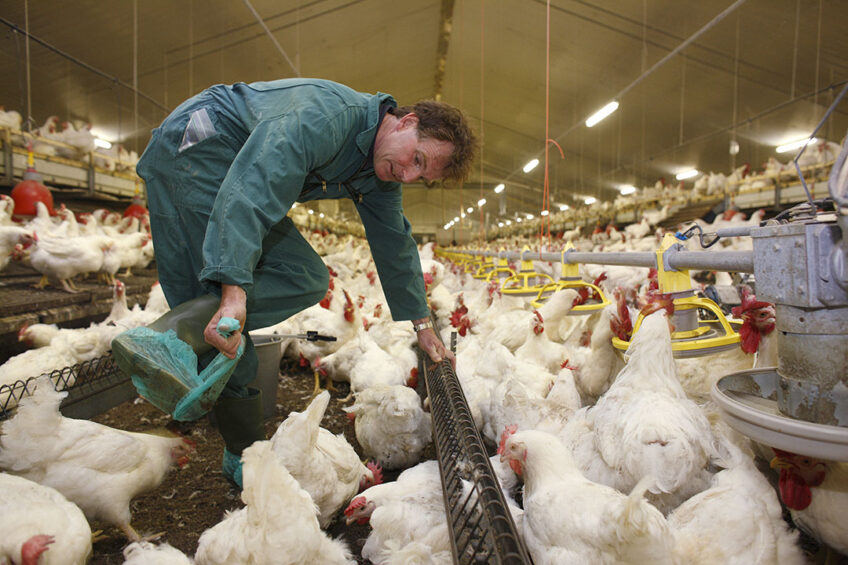Alternative strategies to control salmonella infection in poultry

Salmonella infection is a grave public health problem around the globe, with diarrhoea, fever and abdominal pain as its main symptoms. One of the main sources of infection for the human population is through poultry products, such as meat and eggs. It is therefore essential to apply strategies to control the presence of salmonella in the poultry production chain and to improve food safety.
Salmonella in poultry causes either subclinical disease or no change and thus enhances the likelihood of infection transmission to humans from asymptomatic poultry via the food chain.
According to the Centers for Disease Control and Prevention, salmonella causes 1.35 million infections per year in the United States. Since antibiotic use has been reconsidered due to resistance, alternative strategies based on feeding and non-feeding are recommended to control salmonella infection in poultry and to reduce production costs.
Difficult bug
Salmonella is a gram-negative, anaerobic and non-spore-forming bacillus that belongs to the Enterobacteriaceae family. Salmonella grows under various environmental conditions outside of a living host cell, at temperatures from 7-48°C and pH values between 6.5 and 7.5.
The salmonella genus consists of 2 species: Salmonella enterica and Salmonella bongori. Salmonella enterica includes 2,500 serovars and Salmonella bongori comprises 20 serotypes and 6 subspecies. Salmonella infection is a zoonotic disease which causes economic loss and is a public health concern around the world.
Non-antibiotic feeding-based strategies
The non-antibiotic alternatives to reduce or control salmonella infections in poultry include prebiotics, probiotics, synbiotics, postbiotics and phytobiotics. These supplements are administered through the diet to increase growth performance and improve feed efficiency.
Prebiotics are fibres defined as selectively fermented dietary ingredients that bring about specific changes in both the composition and activity of the gut microbiota with a beneficial physiological effect on the host. Prebiotics, such as fructooligosaccharides, aspergillus meal and trehalose, reduce the incidence and transmission of caecal salmonella and its adverse effects on the poultry gut through modulation of gut microbiota, promotion of molecules associated with resistance to salmonella infection and increasing the accumulation of IgA cells on the intestinal mucosa.
Probiotics
Probiotics are live micro-organisms that can be used to prevent and treat microbial imbalance by altering gut microbiota populations. Dietary supplementation of probiotics increases the bird’s ability to inhibit the growth of pathogenic bacteria, improves production performance, creates antimicrobial compounds such as hydrogen peroxide, lactic acid, bacteriocins and short-chain fatty acids to prevent infection and reduce related negative effects. Species such as Bifidobacterium, Lactobacillus, Bacillus, Enterococcus and Pediococcus are used as probiotics for poultry.
Synbiotics
Synbiotics are described as a combination of prebiotics and probiotics with a synergistic relationship to facilitate the implanting and survival of probiotics in poultry gut. Synbiotics alter gut microbiota composition, activate mechanisms related to salmonella inhibition, decrease the clinical signs of salmonella infection, improve production performance, enhance the immune response, prevent shedding patterns, decrease the abundance of salmonella in the caeca and reduce the intensity and frequency of histopathological injuries in poultry.
Postbiotics
Postbiotics refers to non-viable bacteria or bacterial metabolic products, such as inactivated cells, enzymes, exopolysaccharides, plasmalogens, organic acids, short-chain fatty acids and peptides, mainly produced from lactic acid bacteria. Postbiotics improve amino acid and protein absorption, increase growth performance, stimulate beneficial gut bacteria, such as Lactobacillus, inhibit the adherence of pathogenic bacteria via the lectin domain, compromise pathogenic bacteria cell integrity, trigger the immune response and decrease salmonella-related infections in poultry.

Phytobiotics
Phytobiotics are plant-derived compounds, plant extracts, herbs and spices that are used to improve the health status and productivity parameters of poultry. Plants most often used as phytobiotics include alfalfa, bergamot, peppermint, black cumin, chili, clove, oregano, cinnamon and garlic.
Phytobiotics increase feed intake, stimulate endogenous enzymes, decrease pathogen proliferation, enhance nutrient absorption, increase carcass quality and muscle yield in broilers, stimulate the immune system, lower mortality, increase body weight, improve feed-gain ratios, enhance ileal villus height, width and surface area, increase mucosal thickness and muscular layer thickness, as well as improve growth performance and gut health through mitigation of the negative effects of the disease.
Non-antibiotic non-feeding-based strategies
Bacteriophages and vaccines are viable and technological non-feeding-based strategies implemented to reduce or control salmonella infection in poultry. Bacteriophage application for the control of salmonella infections in poultry is a safe strategy because bacteriophages are always present in the host, protecting the rest of the microbiota.
High titer of bacteriophages in single doses and bacteriophage cocktails have more potential to control salmonella infection. The efficiency of bacteriophage therapy also depends on the adaptation of the bacteria to develop resistance. The synergy between probiotics and bacteriophages enhances recovery by reducing mortality and preventing bacteria spreading.
Vaccines
Vaccination is one the most efficient and cost-effective methods to reduce the impact of clinical disease, maintain herd immunity, decrease shedding, reduce transmission of salmonella in poultry flocks and provide safer food products for consumers.
Salmonella vaccines are divided into 3 categories: live-attenuated, inactivated and subunit vaccines. Live-attenuated salmonella vaccines are administered parenterally or orally, and they colonise the gut and stimulate the immune response. These vaccines can be used immediately after hatching when young poultry are immunologically immature. Inactivated vaccines are based on killed or inactivated pathogens, and are administered to breeders and layer flocks by subcutaneous injection, thereby increasing their immunity, suppressing salmonella colonisation in organs, and reducing shedding into faeces. Subunit vaccines contain 1 or more recombinant peptides/proteins or polysaccharides, and are administered either intramuscularly or subcutaneously.
Potential
Salmonella infection is one of the primary challenges for the poultry industry due to the potential risk of mortality, economic losses and public health threats. Concerns regarding antibiotic resistance has led to the design and validation of alternative strategies to prevent and control salmonella infection. However, further research is required to understand the functional potential of antibiotic-free strategies and to promote their application to reduce and control salmonella infections.













